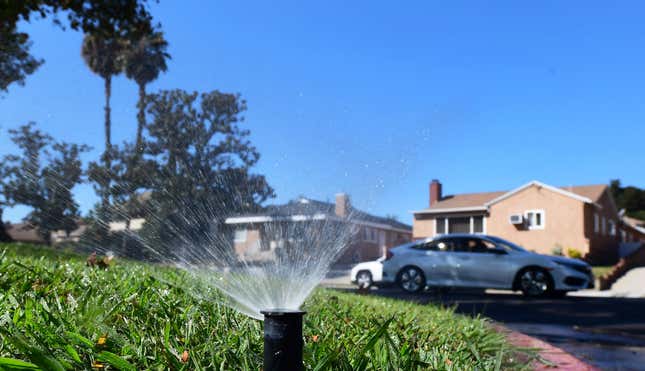
Parts of California are officially in a water emergency, according to a declaration from the Metropolitan Water District of Southern California. On Tuesday, the board of the Metropolitan Water District released a statement announcing “that a Water Shortage Emergency Condition exists in the [State Water Project] Dependent Area.”
As a result, affected people across the region will have to limit their watering of outdoor lawns and gardens to just one day a week starting June 1, and further restrictions could be on the way.
The declaration is the first time in the Metropolitan Water District’s 94-year history that its board has issued restrictions like this, according to a report by the Los Angeles Times. “We are seeing conditions unlike anything we have seen before,” the water district’s general manager, Adel Hagekhalil, told the LA Times. “We need serious demand reductions.”
“This is a crisis, this is unprecedented. We have never done anything like this before,” added Hagekhalil in a press conference on Wednesday.
California is currently experiencing arguably its most severe drought since record keeping began in 1895. The present drought is now in its third year and has devastated farmers and the environment alike. For reference, the Colorado River, which supplies about a quarter of Southern California’s water, is at record-low levels.
Through a network of public water agencies, the Metropolitan Water District brings water to about 19 million people in sections of Los Angeles, Orange, San Diego, Riverside, San Bernardino, and Ventura counties. The new restrictions will impact about 6 million of those people specifically in Los Angeles, San Bernardino, and Ventura counties, said Gloria Gray, the chair of the Metropolitan Water District Board of Directors in Wednesday’s media briefing.
The board’s new requirements specifically state that affected municipalities must either limit peoples’ outdoor watering to one day per week or directly find other ways to equivalently reduce water use. “I want to just really stress how critical this is,” said Hagekhalil. “The amount of water we have available to us now is not going to be enough to carry us through the entire year unless we do something different, unless we take action,” he added. If municipalities don’t cut their use and abide by the new restrictions, they’ll face fines.
Lawn watering accounts for 30% to 70% of individuals’ water usage, according to the Metropolitan Water District’s general manager. So, the cuts should result in much lower water demand. However, if they don’t, Hagekhalil said he’s been granted the authority to issue a total ban on outdoor watering starting September 1.
In Los Angeles and the surrounding areas, peoples’ potable water has to travel long distances. Los Angeles is a coastal desert with limited natural freshwater resources of its own, said Rich Pauloo, a hydrogeologist and data scientist studying California’s water through the Water Data Lab, in a phone call with Gizmodo. “It’s a dry place and it’s getting drier,” Pauloo explained, because climate change has increased Southern California’s risk of drought. “Los Angeles is a thirsty city, and the cup that it’s been drinking from is going to have less water [in the future]. Period,” he said.
Major water sources for LA include the Colorado and Owens rivers, pumped from hundreds of miles away. Then, there’s the State Water Project, which accounts for about 40% of LA’s water supply and brings water from Northern to Southern California through a 705-mile-long network of canals and pipelines that start in the Sierra Nevada Mountains.
“When one supply is facing dry conditions, we can turn to another,” said Hagekhalil. But the system is reaching its limits: In recent months, the State Water Project supply to LA has dropped precipitously. The resources coming from the northern Sierras have been cut by two-thirds, he added. “With this historic drought getting worse,” said Hagekhalil, “we cannot afford green lawns.”